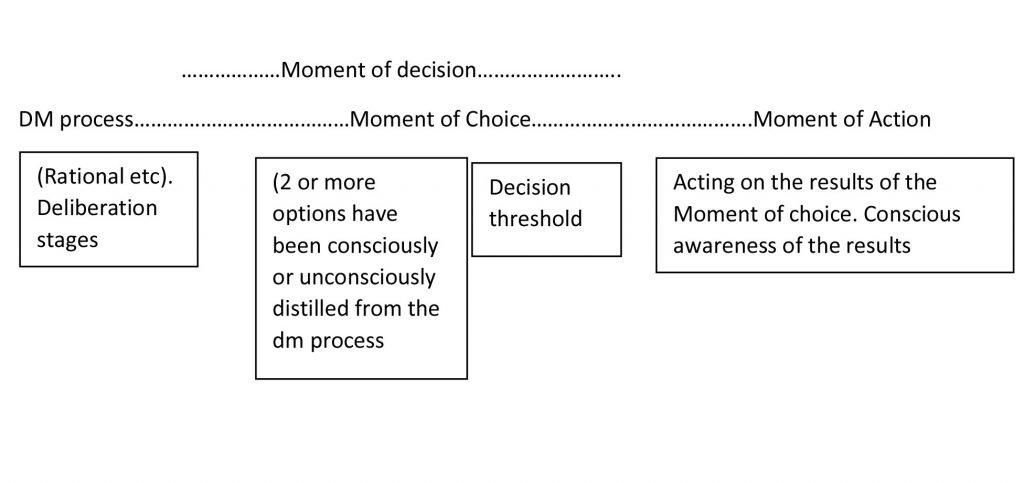Initial ideas for research – early February
A DESCRIPTIVE, DECISION-THRESHOLD MODEL FOR SIMPLE, BINARY DECISION MAKING
A MULTI-STAGED, CASE-BASED, NEURAL DECISION-MAKING MODEL IN THE CONTEXT OF FINANCIAL TRADING
Can neural decision making be deconstructed to highlight individual stages in the Moment of Choice/decision during financial trading
(context: food (low risk) /online trading (risky) /education (could be either)
In mathematics and statistics, a decision threshold refers to a value that enables a quantitative test to result in a simple binary decision. The value of the decision threshold is determined according to the type of test it is being used on.
In the field of neuroeconomics, the term “decision threshold” has been applied to perceptual decision making. Perceptual decisions within the ambit of neuroeconomics are defined as a choice between alternatives based on perceptual sensory input. A famous experiment by xxx where a monkey’s choice between two visual alternatives, resulted in an accumulation of neuronal activity in the direction that the choice was made, illustrated that a decision threshold is reached when neuronal activity accumulates to a specific level.
By combining these two definitions and applying them to simple binary choices a descriptive model that focuses specifically on the pre- and post- Moment of Action can be developed.
The Moment of Decision
In 1938, Edward Tolman, a psychologist, used the concept of choice-point (Tolman, 1938) in his experiments based on earlier research undertaken by Buel and Ballachey (1934). The concept of choice-point has subsequently been used extensively by psychologists (Balleine & Ostlund, 2007), neurologists (Kaplan et al., 2017) and even semanticists (Cariani, 2017) and has subsequently been applied to a variety of psychological fields, albeit increasingly with definitions that differ from the original meaning[1]. In experimenting with rats, Tolman attempted to understand the behavioural decisions that are made at the choice-point. The choice-point is that moment in which a choice (in other words, a decision) needs to be made[2]. Tolman emphasised that reward and punishment were major contributing factors as to whether a rat turned right or left in a maze when confronted with a choice-point (Tolman, 1938, p. 341). The rats were rewarded with food depending on which direction they chose. The relevance of this to the current study is that when faced with a choice (to choose to trade or not to trade or even to do nothing) which parallels Tolman’s choice-point of turning right or left, and through the use of various psychophysiological measurements on a shallow brain level and deep brain activity using an fMRI, Tolman was one of the few researchers to investigate, on a micro level, what occurs after a deliberation process has been completed.
Bearing in mind the diversity of theories to describe decision making, one aspect amongst all theories is common – that at some moment in time, a choice (or several choices) is/are made. Taking this commonality as a starting point, in this study, two terms are introduced by the researcher which are suggested to describe the event that occurs after a decision process has run its course. The first term is called the moment of choice (MoC). This term implies that all the decision-making processes or deliberations (whether using reasoning, intuition, heuristics, framing, adaptive decision making or any of the other, many models of decision making) culminate in a moment[3] when a choice is made. This MoC can be likened to the term ‘decision threshold’ used by several researchers in the context of neurological action (Cavanagh et al., 2011; Domenech & Dreher, 2010; Lo & Wang, 2006). This is followed by a moment of action (MoA) which is the external manifestation of that choice – external because it can be comprehended by the individual or observed by an external party. It parallels the stage of the execution of a decision – a stage mentioned by many theorists but inevitably a stage which is not discussed in detail. Figure xxx below outlines the suggested position of these two concepts in the decision-making process. The MoC and MoA are the stages in decision making that are focused on in this research.

Figure xxx: MoC and MoA in the context of the decision-making process
METHODOLOGY FOR THIS STUDY
Context: food (low risk) /online trading (risky) /education (could be either)
Biometric measurements during the decision-making process
Participants’ inputs of what they think happened
Rationality/intuition
[1] Current popular psychology has enhanced this simple definition of “choice point” to describe several different concepts such as used in Contextual Behavioural Science Therapy which considers the term “choice point” as the moment when it is feasible to choose between values consistent with and inconsistent with behaviour (Ciarrochi, n.d.). In the neuropscychological field, choice point is regarded as an internal neuronal brain configuration through which axons are guided toward desired targets (Catig, Figueroa, & Moore, 2015) The concept of choice point is closely related to the concept of the decision threshold found in the diffusion theory of decision making.
[2] In Tolman’s rat experiments the rats had to either turn left or right
[3] It needs to be stressed that the ‘moment’ referred to in both the definitions given here of MoC and MoA, is in the order of microseconds.